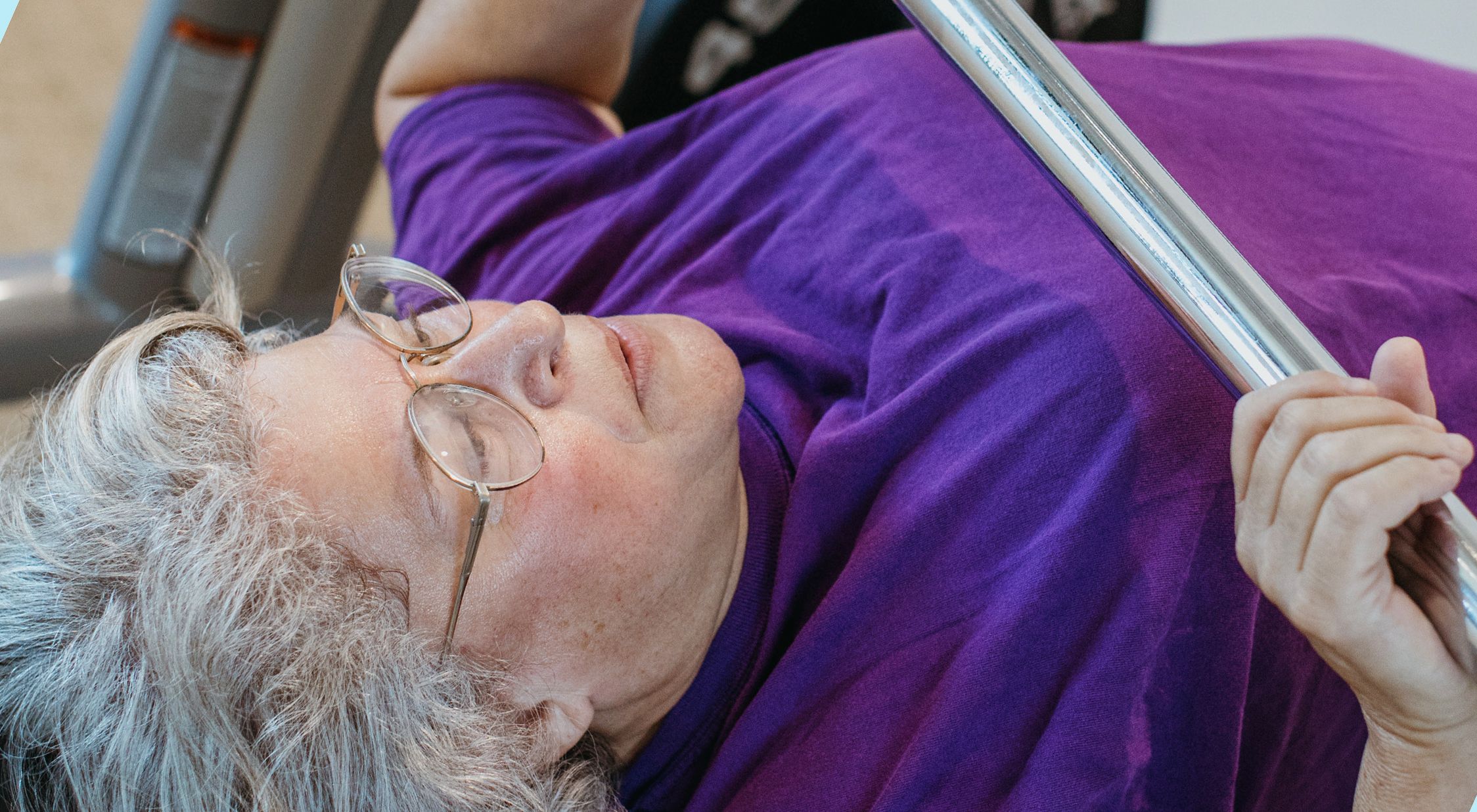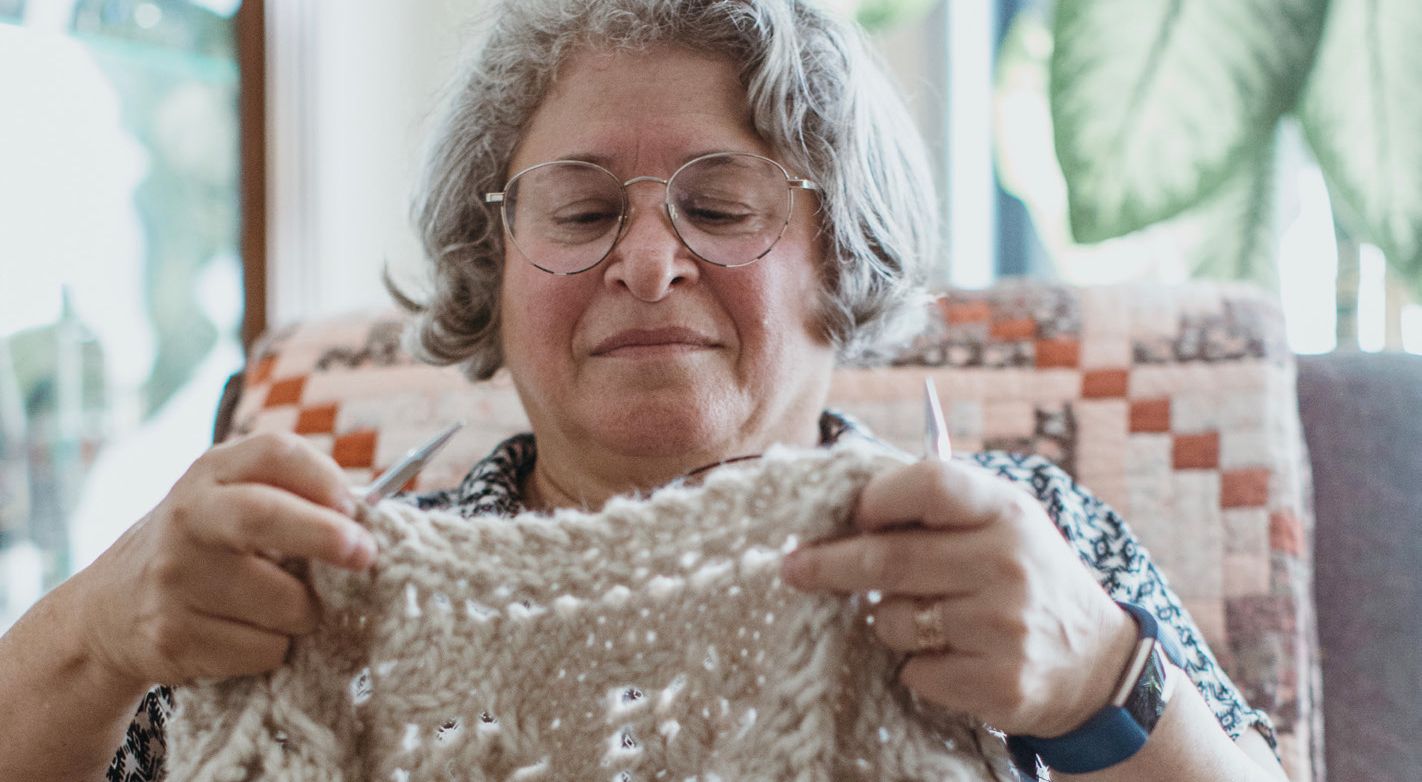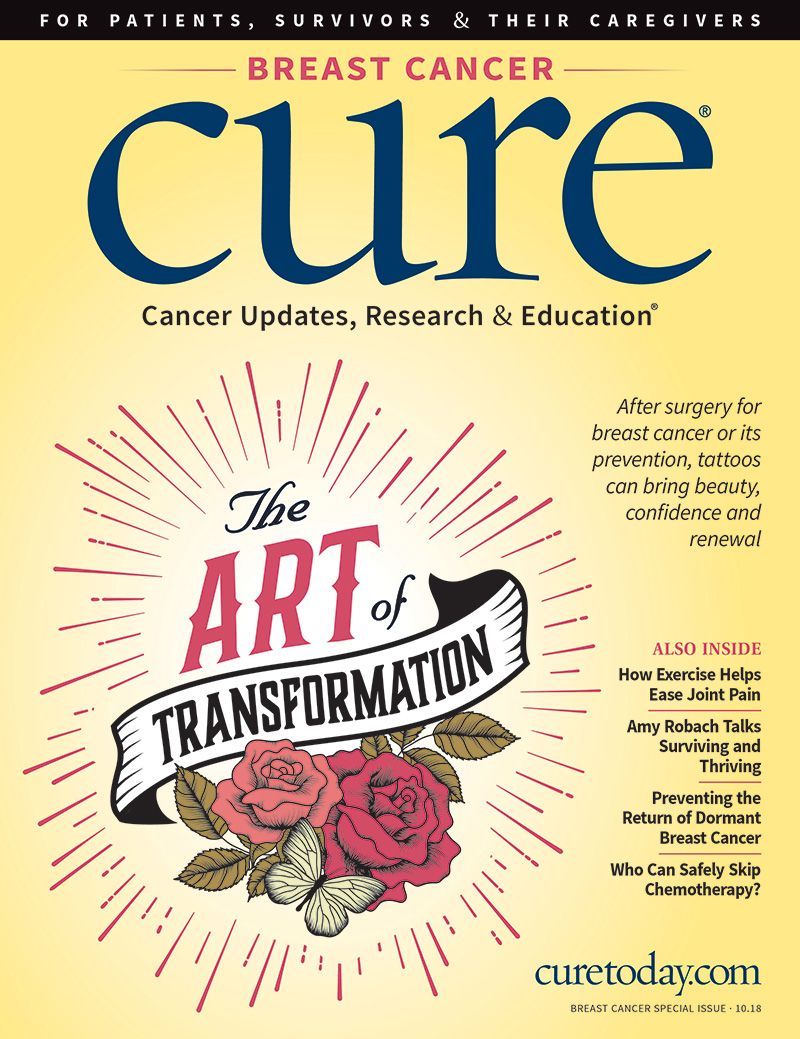Publication
Article
CURE
Flexing Some Muscle to Relieve Joint Pain
Author(s):
Exercise and acupuncture use the body’s physiology to relieve joint pain caused by hormonal treatments after breast cancer.
SYLVIA MORITZ has taken up a varied exercise routine that helps ease her arthralgia. - PHOTO BY MARIA DEFORREST

SYLVIA MORITZ has taken up a varied exercise routine that helps ease her arthralgia. - PHOTO BY MARIA DEFORREST
For some survivors of certain breast cancers, a treatment to prevent recurrence leads to joint pain so severe that they choose to stop taking the drug. But researchers now advise better ways to cope: getting more exercise or trying acupuncture.
The drugs in question are known as aromatase inhibitors (AIs) and are often used after primary treatment, such as surgery, to help prevent recurrence in postmenopausal survivors who have estrogen receptor (ER)-positive breast cancers. By suppressing estrogen, these once-a-day pills help keep recurrences and new cancers at bay and help prevent death from the disease, but for about half of the women who take them, they do so at a painful price — a side effect known as arthralgia, a catch-all term for joint pain and stiffness.
It’s a price that not all survivors are willing to pay, which is why those researching exercise and acupuncture to relieve this side effect are hopeful that the strategies will encourage more women to stick with their AI regimens.
Arthralgia is one of the most common reasons women discontinue taking these drugs, says Dawn Hershman, M.D., M.S., leader of the breast cancer program at the Herbert Irving Comprehensive Cancer Center at New York- Presbyterian Columbia University Medical Center in New York City. Just 50 percent of women prescribed an AI take it at least 80 percent of the time for the recommended full five years, she says, and 25 percent discontinue the drugs. Because arthralgia is not permanent, it typically disappears when treatment stops.
“These women are taking medication to prevent something that might not happen,” Hershman says. “If you’re feeling pain, it’s hard to be motivated to do that.”
Yet there are convincing reasons to persevere. A 2011 study examined adherence to AIs or tamoxifen — another kind of hormonal treatment — and health outcomes in more than 8,700 women with hormone-sensitive breast cancer. The results revealed that, at 10 years, estimated survival was 80.7 percent for women who continued hormonal therapy compared with 73.6 percent for those who stopped. Among those who continued the drugs, survival at 10 years was 81.7 percent in those who adhered to their regimens versus 77.8 percent in women who did not.
“Both early discontinuation and nonadherence to hormonal therapy were common and associated with increased mortality,” wrote Hershman, the lead author, and her colleagues. “Interventions to improve continuation of and adherence to hormonal therapy may be critical to improve breast cancer survival.”
Researchers aren’t sure what’s behind the joint pain and stiffness that occur in many women who take AIs. Amy Comander, M.D., a medical oncologist at the Massachusetts General Hospital Cancer Center-affiliated Vernon Cancer Center in Newton, Massachusetts, and medical director of the Auerbach Breast Center at Newton- Wellesley Hospital, says that although it can be difficult to sort out the origin of joint pain, estrogen plays an important role in the body and overall bone health. AIs — Femara (letrozole), Arimidex (anastrozole) and Aromasin (exemestane) — work to lower estrogen levels. When the hormone is suppressed, arthralgia symptoms can develop quickly.
It’s not easy for doctors to predict who might develop AI-induced arthralgia. Researchers have not pinpointed any clear signals that the condition will develop, although study results do suggest a few signals: previous treatment with hormone replacement or chemotherapy, being menopausal for five years or less and having pre-existing joint problems. Taking tamoxifen before an AI, on the other hand, has been found to potentially reduce a woman’s likelihood of experiencing arthralgia.
MOVING THROUGH PAIN
Sylvia Moritz, 62, of Ocean View, Delaware, says her arthralgia began “almost immediately” when she started taking Femara, which her oncologist prescribed after she was treated for invasive micropapillary carcinoma, an ER-positive breast cancer. “I could feel it building up over the first three to four weeks,” she says.
Fortunately, promising evidence supports two medication- free methods for managing arthralgia discomfort: exercise and acupuncture. Exercise’s beneficial effects on weight control, mood and general well-being are often cited, and the yearlong HOPE (Hormones and Physical Exercise) study, published in 2015 in the Journal of Clinical Oncology, examined whether it could also help relieve the severity of AI-induced arthralgia in 121 survivors of breast cancer.
“We found exercise to be associated with a 30 percent improvement in arthralgia associated with AI use,” says lead author Melinda Irwin, Ph.D., M.P.H., a professor of epidemiology at the Yale School of Public Health and an associate director of the Yale Cancer Center in New Haven, Connecticut. At the study’s outset, women rated their arthralgia pain on a scale of zero to 10, all reporting a 3 or higher. Those who spent a year in the study’s exercise group experienced an average decrease in pain of 1.6 points, whereas those in the group receiving usual care (no prescribed exercise) experienced a 0.2-point increase in pain. “Many of the women who participated in our study were concerned about exercising, as they thought this would increase their joint pain, but after just a couple months of following our exercise program, they were physically stronger, activities of daily living were easier, and they had less pain,” Irwin says.
Moritz attests to the positive impact of exercise in managing her arthralgia symptoms. Her oncologist told her to expect some joint pain, particularly in her hips, knees and fingers, when she began taking Femara. But the pain was excruciating, she says, especially if she sat for a long time. Her doctor encouraged her to exercise.
SYLVIA MORITZ finds that knitting helps control arthralgia in her hands. - PHOTO BY MARIA DEFORREST

SYLVIA MORITZ finds that knitting helps control arthralgia in her hands. - PHOTO BY MARIA DEFORREST
“Standing up could be an exercise in torture,” Moritz says. But the worst pain was in her fingers. Following the advice of a friend, she took up knitting as a way to exercise her hands. “It was the only thing that would keep my fingers moving and relieve the pain,” she says.
She also began walking and added weight training. “That helped because I started to build muscle mass, which took the strain off my joints,” she says. “My joints still hurt, but they hurt a lot less. The pain didn’t go away, but exercise alleviated it to the point where I was functional.”
Today, Moritz, who finished a five-year course of AIs, still walks 5 miles every day, lifts weights a few times a week and pedals her bicycle through her neighborhood. She encourages others dealing with arthralgia to just keep moving. Moritz’s exercise regimen is in line with the program used in the HOPE study. Participants walked briskly outside or on a treadmill and performed six common strength-training exercises: leg presses, leg extensions, leg curls, bench presses, pull downs and seated rows. The exercises can be done at a gym, but Irwin also recommends finding out if a local YMCAs offer the Livestrong Program, a free or low-cost exercise plan that gives cancer survivors the opportunity to work with certified personal trainers (livestrong.com). “This will allow them to learn how to exercise safely and at the appropriate intensity, in turn improving their arthralgia and other cancer outcomes,” Irwin says.
Comander says she typically asks patients to describe their pain and might prescribe an exercise program similar to the one used in the study. “Many say, ‘I get out of bed in the morning and I feel like an old lady,’” she says. “Some people feel pain not just in the morning but all day. I try to get a sense of how severe the pain is.”
Hospital programs can help people who haven’t exercised regularly learn how to do it safely and effectively, Comander says. Her facility offers a staff physiatrist — a physician specializing in physical medicine and rehabilitation — who helps uncover sources of joint pain and creates strategies to manage it, including exercise such as yoga, Pilates, walking, Zumba, tennis, swimming or biking. Physical therapy might also be recommended.
NEW EVIDENCE FOR ACUPUNCTURE
JODI MONROE bikes and competes in dragon boat races to help control her arthralgia. - PHOTO BY ANNABEL CLARK

JODI MONROE bikes and competes in dragon boat races to help control her arthralgia. - PHOTO BY ANNABEL CLARK
Those who already exercise should continue their regular workouts, Comander says. Jodi Monroe, 53, of Mount Vernon, Washington, was already an avid exerciser when she received a diagnosis of breast cancer — stage 3a triple-positive ductal carcinoma — at age 47. She had a mastectomy on her left side, followed by eight months of bio-chemotherapy and the placement of a skin expander to prepare for reconstruction. After facing an infection that required another emergency surgery, Monroe had 30 rounds of radiation, followed by a course of tamoxifen. She then began taking Arimidex.
“I never quit exercising, which probably has gotten me where I am,” she says. Still, the bone and joint pain she felt during her first year on the AI was debilitating. “I was at a business meeting, and I couldn’t even sit down,” she says.
After ruling out recurrence in the bone, her oncologist recommended acupuncture to help deal with the arthralgia. Monroe took part in a multicenter randomized clinical trial that compared the effects of true acupuncture, sham acupuncture (shallow insertion of needles at nonacupuncture points) and no treatment (the control group) on AI-related joint pain in women with early-stage breast cancer. The study, published in July 2018 in JAMA, found that women who received true acupuncture had less joint pain after six weeks compared with those in the sham and control groups.
Although Monroe doesn’t know which group she was assigned to — sham or real acupuncture — she has continued acupuncture treatments since the study ended. Previously, she was a naysayer regarding treatments like acupuncture and chiropractic care, she recalls. “I’d had muscle pain from weight lifting, but mainly, I’d just gut it out,” she says. “But I hadn’t experienced bone pain like this. With acupuncture, I’d see a huge difference in pain for a few weeks after treatment.”
Hershman, the study’s lead author, says that not only did participants who received true acupuncture have less pain after six weeks of treatment, they also had reduced joint stiffness — and those effects persisted throughout the 24-week intervention.
“Our goal as practitioners is to help patients stay on medications that are effective,” Hershman says. “Acupuncture has low toxicity and provides benefit to some. It gives us something different to offer to patients who are suffering.”
Heather Greenlee, N.D., Ph.D., a co-author of the study, medical director of the Integrative Medicine Program at Seattle Cancer Care Alliance and an epidemiologist at Fred Hutchinson Cancer Research Center in Seattle, said she expects to see an uptick in the use of acupuncture to help manage arthralgia. In May 2018, the American Society of Clinical Oncology endorsed the Society for Integrative Oncology’s evidence-based clinical guidelines on integrative therapies, including acupuncture, for managing symptoms and side effects of cancer and its treatment.
“We want to get this information (about acupuncture relieving arthralgia) into the hands of patients and clinicians,” Greenlee says. Those who want to try the technique should find an acupuncturist who is trained to work with oncology patients, she says, and can follow the study’s recommended point protocol online. A list of the acupuncture points can be accessed at https://tinyurl.com/y7a6mmdb.
Acupuncture does have some potential drawbacks, Hershman adds. Some people are afraid of needles; others can’t afford the time or cost. Each session runs $60 to $120, on average, and might not be covered by insurance. Coverage for acupuncture treatments varies by state, as well as according to a plan’s particulars, Greenlee says.
“That’s one of the main reasons we did the study — to provide level one evidence” of acupuncture’s effectiveness, Hershman says, which could lead to more insurance coverage. Monroe’s plan covered a certain number of acupuncture sessions each year; after that, she paid out of pocket. “My health and comfort come first,” she says. Hershman urges others to follow Monroe’s lead.
Anyone taking AIs and experiencing arthralgia symptoms should talk to their oncologist. “Don’t stop taking your medication,” she says. She encourages all patients to exercise, unless there’s a reason they shouldn’t, and eat a healthy diet — it might not ease arthralgia but can help to both maintain a normal body weight and prevent recurrence. Those interested in acupuncture but worried about the cost can check with their cancer centers to see if there’s an acupuncturist on staff or seek a referral to one who offers reduced fees for patients with cancer. Acupuncture can also be found in a clinic environment, where a number of people are treated simultaneously at reduced rates. A list of clinics by state is offered by the People’s Organization of Community Acupuncture at pocacoop.com.
Monroe, who still takes Arimidex every day, credits exercise and acupuncture with helping her continue high-level athletic pursuits, including a 200-mile Seattle-to-Portland bike ride and training for a dragon boat competition in Hungary, where she competed in the Club Crew World Championships.
“Because I’m high risk, I’m going to stay on an AI for life,” she says, adding that her stage 3a diagnosis included a golf ball-size node in her armpit and seven additional positive lymph nodes. “But acupuncture, exercise, massage and a good attitude have gotten me through a lot.”




